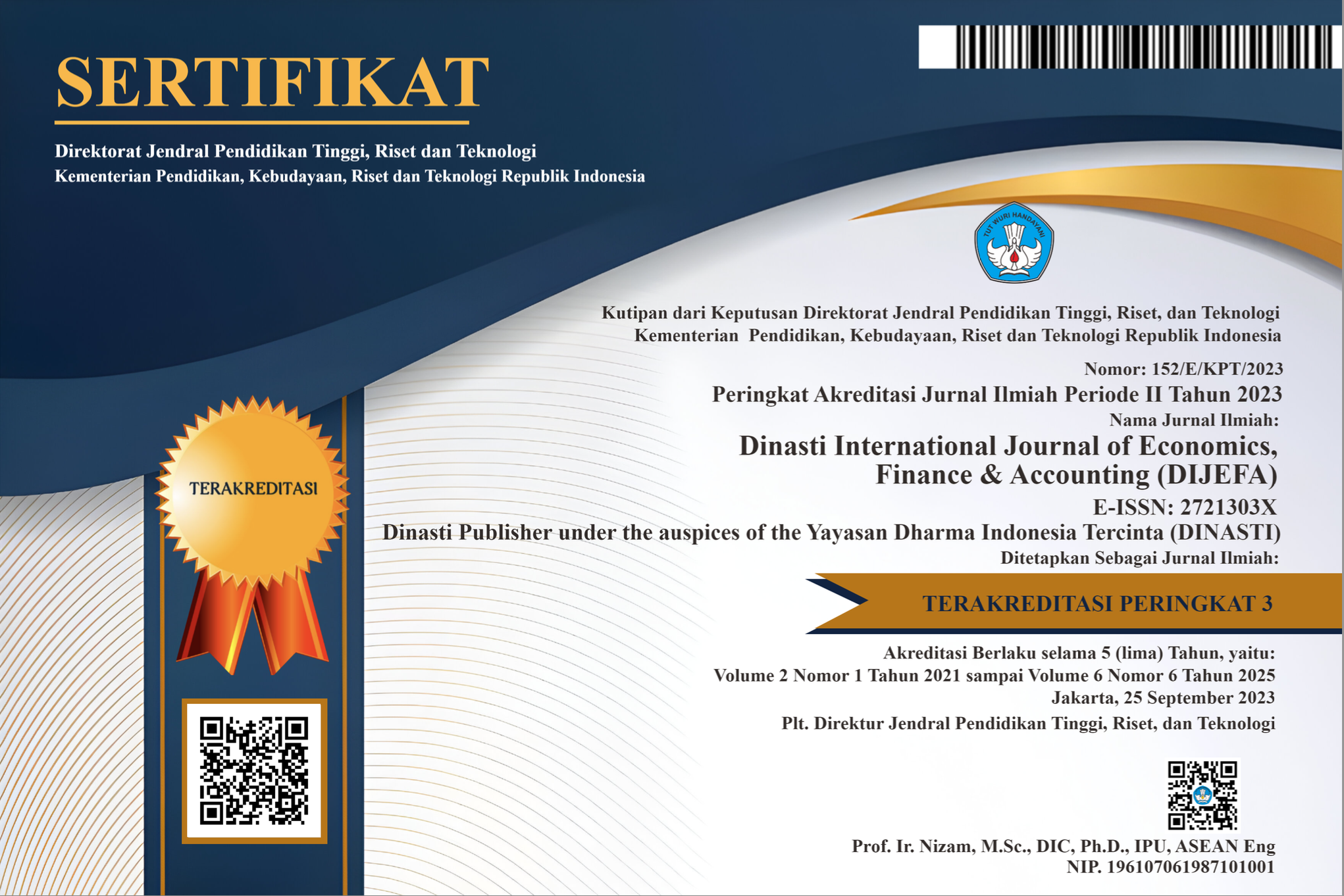The Influence of Forced Distribution Rating System (FDRS) on Job Performance : The Mediation Role of Effort , Stress , Procedural Justice, and Distributive Justice Empirical Study on Employees at Bank Indonesia Head Office
DOI:
https://doi.org/10.38035/dijefa.v6i2.3995Keywords:
Forced Distribution Rating System, Job Performance, Effort, Stress, Procedural Justice, Distributive JusticeAbstract
Job performance considered important for organizational effectiveness and can be optimized through well-designed and implemented performance appraisals to motivate employees. One of the measurement models is Forced Distribution Rating System (FDRS). The main objective of this study was to assess the effect of FDRS on job performance mediated by effort , stress , procedural justice , and distributive justice. The research data were obtained from 380 respondents through online and offline questionnaires that had undergone initial cleansing and filtering, analyzed using Covariance-Based Structural Equation Modeling (CBSEM) with the Confirmatory Factor Analysis (CFA) method using the LISREL 8.8 application . The test results showed that the Forced Distribution Rating System (FDRS) had a significant positive effect on effort (H1), procedural justice (H3), and distributive justice (H4). Effort was shown to have a significant effect on job performance (H5), while procedural justice (H7) and distributive justice (H8) also had a strong positive relationship with job performance . Effort significantly mediated the relationship between FDRS and job performance (H9), while procedural justice (H11) and distributive justice (H12) were also important mediators. In contrast, FDRS has no significant effect on stress (H2), and stress does not mediate the relationship between FDRS and job performance (H10). These findings underscore the importance of a justice-based approach in implementing an evaluation system such as FDRS to support optimal employee performance.
References
Adsit DJ, Bobrow WS, Hegel PS, Fitzpatrick BG (2018) The return on investment of rank and yank in a simulated call-center environment. Consult Psychol J 70:113–128. https://doi.org/10.1037/cpb00 00103
Angelovski, A. , Brandts, J. , Sola, C. , 2016. Hiring and escalating bias in subjective performance evaluations: a laboratory experiment. J. Econ. Behav. Organ. 121, 114–129.
Berger, J. , Harbring, C. , Sliwka, D. , 2013. Performance appraisals and the impact of forced distribution – an experimental investigation. Manag. Sci. 59, 54–68.
Blume BD, Baldwin TT, Rubin RS (2009) Reactions to different types of forced distribution performance evaluation systems. J Bus Psychol 24:77–91. https://doi.org/10.1007/s10869-009-9093-5
Blume BD, Rubin RS, Baldwin TT (2013) Who is attracted to an organization using a forced distribution performance management system? Hum Resour Manag J 23:360–378. https://doi.org/10.1111/1748- 8583.12016
Cardinaels E, Feichter C (2021) Forced rating systems from employee and supervisor perspectives. J Account Res 59:1573–1607. https://doi.org/10.1111/1475-679X.12388
Chattopadhyay R (2019) Impact of forced distribution system of performance evaluation on organizational citizenship behavior. Glob Bus Rev 20:826–837. https://doi.org/10.1177/0972150917721819
Colquitt, JA , Conlon, DE , Wesson, MJ , Porter, CO , Ng, KY , 2001. Justice at the millennium: a meta-analytic review of 25 years of organizational justice research. J. Appl. Psychol. 86(3), 425–445
Croson R, Fatas E, Neugebauer T, Morales AJ (2015) Excludability: a laboratory study on forced rank- ing in team production. J Econ Behav Organ 114:13–26. https://doi.org/10.1016/j.jebo.2015.03.005
Deci, E.L., & Ryan, R.M. (2017). Self-Determination Theory: Basic Psychological Needs in Motivation, Development, and Wellness. Guilford Publications
Guralnik O, Rozmarin E, So A (2004) Forced distribution: is it right for you? Hum Resour Dev Q 15:339–345. https://doi.org/10.1002/hrdq.1107
Judge, T.A., Kammeyer-Mueller, J.D., & Scott, B.A. (2018). The Experience of Work: Effort, Reward, and Well-Being. Journal of Organizational Behavior, 39(2), 148-162.
Kahya, E. (2009). The effects of job performance on effectiveness. International Journal of Industrial Ergonomics, 39(1), 96-104.
Kozlowski, SW, 2017. Enhancing the effectiveness of work groups and teams: a reflection. Perspect. Psychol. Sci. 13, 1–8.
Loberg L, Nüesch S, Foege JN (2021) Forced distribution rating systems and team collaboration. J Econ Behav Organ 188:18–35. https://doi.org/10.1016/j.jebo.2021.04.035
Luffarelli J, Gonçalves D, Stamatogiannakis A (2016) When feedback interventions backfire: Why higher performance feedback may result in lower self-perceived competence and satisfaction with performance. Hum Resour Manag 55:591–614. https://doi.org/10.1002/hrm.21739
Machegiani, L. , Reggiani, T. , Rizzolli, M. , 2016. Loss averse agents and lenient supervisors in performance appraisals. J. Econ. Behav. Organ. 131, 183–197.
Malhotra G, Mukherjee A (2013) Comparative study of forced distribution and absolute rating performance management systems. Int J Bus Excell 6:121–130. https://doi.org/10.1504/IJBEX.2013. 052475
Maslach, C., & Leiter, M. P. (2016). Burnout in the Workplace: A Special Topic. Annual Review of Organizational Psychology and Organizational Behavior, 1(1), 397-422.
Moon, SH, Scullen, SE, Latham, GP, 2016. Precarious curve ahead: the effects of forced distribution rating systems on job performance. Hum. Resour.Manag. Rev. 26, 166–179.
Motowidlo, S. J., Borman, W. C., & Schmit, M. J. (2014). A theory of individual differences
in task and contextual performance. In Organizational Citizenship Behavior and Contextual Performance (pp. 71-83). Psychology Press.
Schleicher DJ, Bull RA, Green SG (2009) Rater reactions to forced distribution rating systems. J Manag 35:899–927. https://doi.org/10.1177/0149206307312514
Scullen SE, Bergey PK, Aiman-Smith L (2005) Forced distribution rating systems and the improvement of workforce potential: a baseline simulation. Pers Psychol 58:1–32. https://doi.org/10.1111/j.1744- 6570.2005.00361.x
Stewart SM, Gruys ML, Storm M (2010) Forced distributed performance evaluation systems: advan- tages, disadvantages and keys to implementation. J Manag Organ 16:168–179. https://doi.org/10. 5172/jmo.16.1.168
McKinney WR, Mulvaney MA, Grodsky R (2013) The development of a model for the distribution of merit pay increase monies for municipal agencies: a case study. Public Press Manag 42:471–492. https://doi.org/10.1177/0091026013495766
Phuong TH (2018) Perceived justice in performance appraisal among Vietnamese employees: antecedents and consequences. Int J Bus Excell 15:209–221. https://doi.org/10.1504/IJBEX.2018. 091920
Roch SG, Sternburgh AM, Caputo PM (2007) Absolute vs relative performance rating formats: implications for fairness and organizational justice. Int J Cell Assess 15:302–316. https://doi.org/10.1111/j. 1468-2389.2007.00390.x
Shaw, J.D., Gupta, N., Delery, J.E., 2002. Pay dispersion and workforce performance: moderating effects of incentives and interdependence. Strategy. Manag .
Tremblay, M., & Roussel, P. (2017). Influence of work stress on employee performance and commitment: A study of the mediating role of motivation. Human Resource Development Quarterly, 28(2), 189-210
Downloads
Published
How to Cite
Issue
Section
License
Copyright (c) 2025 Ardhi Fareza

This work is licensed under a Creative Commons Attribution 4.0 International License.
Authors who publish their manuscripts in this journal agree to the following conditions:
- The copyright on each article belongs to the author(s).
- The author acknowledges that the Dinasti International Journal of Economics, Finance & Accounting (DIJEFA) has the right to be the first to publish with a Creative Commons Attribution 4.0 International license (Attribution 4.0 International (CC BY 4.0).
- Authors can submit articles separately, arrange for the non-exclusive distribution of manuscripts that have been published in this journal into other versions (e.g., sent to the author's institutional repository, publication into books, etc.), by acknowledging that the manuscript has been published for the first time in the Dinasti International Journal of Economics, Finance & Accounting (DIJEFA).


























































